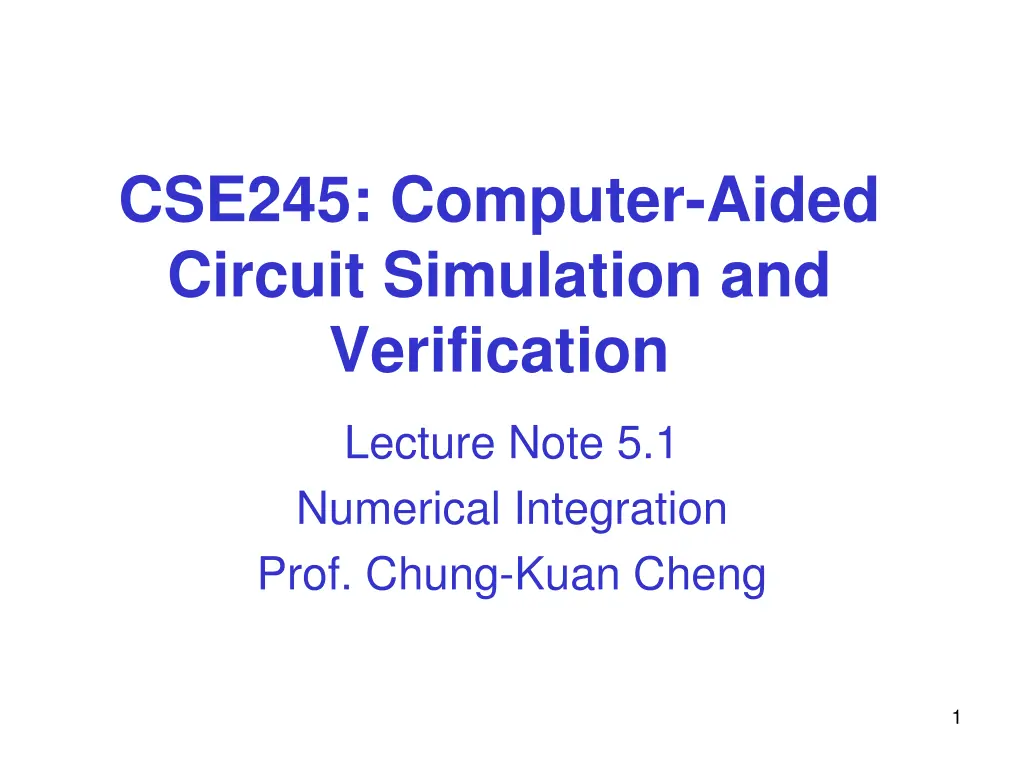
Circuit Simulation and Numerical Integration Methods
Learn about numerical integration methods such as Richardson extrapolation, Bulirsch-Stoer method, Rosenbrock method, predictor-corrector method, and matrix exponential in computer-aided circuit simulation. Explore the Bulirsch-Stoer method's approach, caveats, extrapolation, and step-size control. Understand Rosenbrock methods for ordinary differential equations and the Runge-Kutta method's fourth-order process.
Download Presentation

Please find below an Image/Link to download the presentation.
The content on the website is provided AS IS for your information and personal use only. It may not be sold, licensed, or shared on other websites without obtaining consent from the author. If you encounter any issues during the download, it is possible that the publisher has removed the file from their server.
You are allowed to download the files provided on this website for personal or commercial use, subject to the condition that they are used lawfully. All files are the property of their respective owners.
The content on the website is provided AS IS for your information and personal use only. It may not be sold, licensed, or shared on other websites without obtaining consent from the author.
E N D
Presentation Transcript
CSE245: Computer-Aided Circuit Simulation and Verification Lecture Note 5.1 Numerical Integration Prof. Chung-Kuan Cheng 1
Numerical Integration: Outline Richardson extrapolation (Bulirsch-Stoer) Rosenbrock method (Runge Kutta) Predictor-corrector method Matrix exponential 2
Bulirsch-Stoer Method Caveats: Nonsmooth function: RK Contain singular points: RK Very smooth and right-hand sides expensive to compute: Predictor-corrector 4
Bulirsch-Stoer Method Approach: Modified midpoint method Extrapolation Stepsize control 5
Bulirsch-Stoer Method: midpoint method Given dx/dt=f(t,x), H and n, set h=H/n z0=x(t) z1=z0+hf(t,z0) zm+1=zm-1+2hf(t+mh,zm) for m=1,2, .., n-1 x(t+H): xn=1/2[zn+zn-1+hf(t+H,zn)] Error: xn-x(t+H)= i=1aih2i [1,2,3] Example Sequence: n=2,4,6,8,10,12,14, (Deuflhard) 6
Bulirsch-Stoer Method: Extrapolation T00 T10 T11 T20 T21 T22 Tk0=xk Tk,j+1=Tkj+(Tkj-Tk-1,j)/[(nk/nk-j)2-1], j=0,1, ,k-1 Solution: Tkk Error: |Tkk-Tk,k-1| Errk: H2k+1 7
Bulirsch-Stoer Method: Stepsize Control Stepzie Hk=HS1(S2/errk)1/(2k+1) Complexity A0=n0+1 Ak+1=Ak+nk+1 Work per unit step Wk=Ak/Hk Strategy minimize Wk ([4].17.3.3) For y(x+H) yn+(yn-yn/2)/3, we use 1.5 derivative evaluations per step h. For Runge-Kutta, it takes 4 evaluations. 8
Rosenbrock Methods ODE: dx/dt=f(x) Stepsize: h Process: x(t0+h)=x0+ i=1,sbiki (1-rhf )ki=hf(x0+ j=1,i-1aijkj)+hf j=1,i-1rijkj, i=1, ,s Runge-Kutta: r=rij=0 for all ij. 9
Rung-Kutta Method (4th order) For 4th order RK method, we evaluate the derivatives four times: once at the initial points, twice at trial midpoints, and once at a trial endpoint. The final solution is calculated from the 4 derivatives. k1= hf(tn, xn) k2=hf(tn+0.5h, xn+0.5k1) k3= hf(tn+0.5h, xn+0.5k2) k4= hf(tn+h, xn+k3) xn+1=xn+1/6k1+1/3k2+1/3k3+1/6k4+O(h5) 10
Predictor-Corrector Methods: Admas-Bashforth ODE: dx/dt=f(x) Predictor xn+1=xn+h/12(23fn-1-16fn-1+5fn-2)+O(h4) Corrector xn+1=xn+h/12(5fn+1+8fn-fn-1)+O(h4) 11
References 1. J.A. Gaunt, The deferred approach to the limit, II- interpenetrating lattices, Trans. Roy, Soc., Lond. 226, 350-361, 1927 2. R. De Vogelaere, On a paper of Gaunt concerned with the start of numerical solutions of differential equations, Z. Angew. Math. Phys, 151-156, 1957 3. W.B. Gragg, On extrapolation algorithms for ordinary initial value problems, J. of SIAM, 384-403, 1965 4. W.H. Press, S.A. Teukolsky, W.T. Vetterling, B.P. Flannery, Numerical recipes, 3rd Edition, 2007 12
